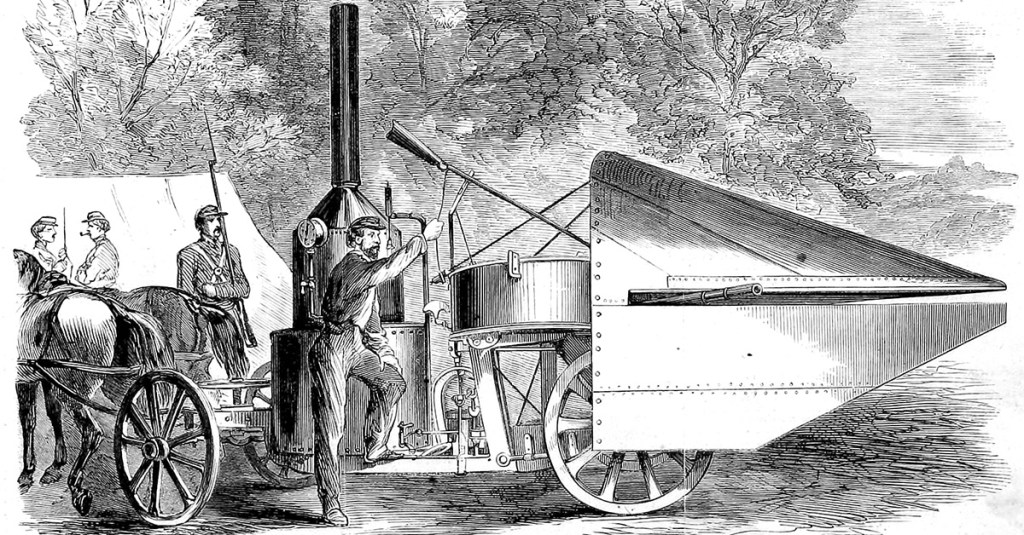

The Civil War was one of the first industrialized wars, helping lead the world from battles conducted by marching men with muskets around each other on a large field to battles fought between small, quick-moving formations with repeating rifles, quick-firing guns, and higher-powered artillery. But not all of the weapon designs that debuted had a lasting effect on warfare.
And one of the designs that fell by the wayside was the quite weird “steam-powered cannon.”
As the world entered the late 1800s, breakthroughs in technology like steam engines and metallurgy allowed the world to make great industrial breakthroughs, and weapon designers hoped to harness those breakthroughs to make the U.S. military more powerful.
William Joslin and Charles S. Dickinson thought the breakthroughs in steam could make a lost weapon design suddenly work: Steam-powered guns. And they had a plan to greatly increase the rate of fire of weapons, possibly as high as 400 rounds per minute. And this was when muskets fired at 3 rounds per minute.
Historically, steam powered guns worked similarly to a conventional rifle, but instead of relying on gunpowder exploding to create high pressure and propel the bullet out of the barrel, they featured a chamber filled with water that would be heated into steam.
When water is heated into steam, it expands to 1,600 times its starting volume. So, it can give a bullet plenty of umph, but it takes a lot of time and heat to build up the pressure necessary to fire the weapon.
But Joslin and Dickinson were at the forefront of a new, steam-powered weapon design. Instead of using steam to build up pressure in the firing chamber, a steam engine would quickly rotate a mechanism and fire the round using centrifugal force.
Basically, this is a mechanized version of David and his sling to hit Goliath, but at 400 rounds per second.
The design showed promise, but the inventors had a falling out, so Dickinson created his own version and won funding for a prototype in 1860. By 1861, it was on display in Baltimore. History buffs will notice that the Civil War started in 1861, so this was an auspicious time to show off a new weapon design. Which, yes, could fire 400 balls per minute.
A steam engine powered a rotary wheel that flung ball ammunition in a closed circle before releasing it at high speeds from a barrel that could pivot within a large metal shield protecting the crew. The entire device was weighty, requiring a large boiler in addition to the barrel, rotary, and shield, and typically had to be moved with horses.
A member of the crew needed to keep feeding balls into the weapon as it tore through rounds. And it wasn’t horribly accurate, so they really needed to keep the balls going. While the weapon is sometimes described as a cannon, it fired .38-caliber rounds, larger than a 7.62mm round but still 24 percent smaller than a .50-cal.
But the worst shortcoming of the weapon was the actual speed of the rounds when they left the barrel. The centrifugal force couldn’t generate nearly the velocity that a chemically propelled or even steam-pressured round enjoyed. In fact, the Mythbusters built one and tested it, and they couldn’t get the rounds to pierce a pig at just a few feet.
Media coverage of the weapon at the time managed to muddle up some details, and the weapon became associated with Ross Winans, a states-right activist and steam expert in Maryland. The public became worried that this was a super weapon and Winans could deliver it to the Confederacy. The weapon even became known as the Winans Gun.
Baltimore police seized the weapon and then returned it to Dickinson who later tried to sell it to the Confederates. Union forces seized the weapon and it served during the war in a number of defensive positions at infrastructure in the North, but it never saw combat.
Machine Gun Powered By Steam – Mythbusters
While it would be cool to say that the weapon went on to change warfare or inspire new weapons that were wildly successful, the truth is that the invention of the Gatling gun and then proper machine guns made the steam-powered Winans Gun unnecessary.
And while the Winans showed some promise during the Civil War, when its high rate of fire made it seem worth the effort to improve the weapon’s muzzle velocity, other weapon breakthroughs that were incompatible with the Winans relegated it to the dustbin.
The increased prevalence of rifled barrels didn’t work well with centrifugal weapons, and weapon cartridges allowed other weapons to catch up in rate of fire but didn’t benefit centrifugal weapons. And as it became clear that attacking forces needed to become more mobile, a massive weapon requiring a steam boiler was a clear loser.
Steam obviously still has a role in warfare, nearly all nuclear-powered weapons we’ve ever designed used steam to carry the power from the reactor. But steam projectiles have, sadly, disappeared, ruining our plans for the SteamPunk Revolution.